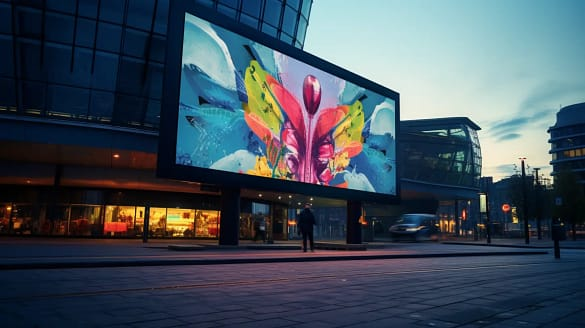A Complete Guide to Outdoor LED Displays, Key Features, and Buying Decisions for Modern Businesses
Introduction: Outdoor Digital Signage in 2025 — What Businesses Must Know
The global digital signage market is evolving faster than ever, and outdoor LED screens are at the forefront of this transformation. As brands continue investing in dynamic advertising, high-brightness LED billboards, and outdoor digital information systems, the demand for weatherproof, energy-efficient, high-resolution LED displays is skyrocketing.
In 2025, choosing the right outdoor LED screen is no longer a simple decision. Businesses must consider a wide range of technical factors — from pixel pitch and brightness levels to IP rating, installation method, content management software, and return on investment.
This comprehensive guide will help you understand:
✔ What outdoor LED screens are
✔ Why they matter for businesses today
✔ How to choose the right outdoor LED display in 2025
✔ Key features to evaluate before purchasing
✔ Outdoor LED screen FAQs
✔ How AIScreen delivers seamless integration and cloud-based content management
Let’s dive deeper into the world of next-generation outdoor LED signage.
What Are Outdoor LED Screens?
A Modern Definition for 2025
Outdoor LED screens — also called outdoor LED displays, LED billboards, digital signage boards, or outdoor video walls — are high-brightness, weather-resistant digital displays designed to operate in open environments. These screens use light-emitting diode (LED) technology to produce vibrant, high-contrast images that remain visible under direct sunlight.
How Outdoor LED Screens Work
The display surface is composed of thousands of LED pixels, which emit light independently. The pixel configuration determines resolution, brightness, and viewing distance.
Outdoor LED displays typically use:
● SMD LEDs (Surface Mounted Device): More modern, wide viewing angles, high color consistency
● DIP LEDs (Dual In-line Package): Extremely bright, durable, ideal for harsh outdoor conditions
Key Characteristics of Outdoor LED Screens
● Brightness levels of 5,000–10,000 nits
● IP65 or IP66 waterproof protection
● Durable aluminum or steel cabinets
● UV-resistant surfaces
● High refresh rates (3840Hz–7680Hz)
● Advanced heat dissipation systems
● Wide operating temperature range (-30°C to 60°C)
Common Applications
Outdoor LED screens are now used in nearly every industry:
● DOOH advertising (Digital Out-of-Home)
● Retail storefronts
● Stadium scoreboards and perimeter screens
● Highway LED billboards
● Outdoor shopping districts
● Transportation hubs (airports, train stations, bus stops)
● Government information panels
● Smart city infrastructure
● Event and concert stages
In 2025, outdoor LED displays are becoming essential tools for communication, customer engagement, and digital transformation.
Why Does Your Business Need Outdoor LED Screens?
Outdoor LED screens are reshaping how brands communicate with their audiences. Businesses in 2025 face new expectations: real-time information, immersive experiences, dynamic advertising, and high visibility in every environment.
Here are compelling reasons why your business should consider investing in outdoor digital signage this year.
1. Maximum Visibility in Any Environment
Outdoor LED screens offer unmatched visibility, even under direct sunlight. With high brightness, advanced contrast ratios, and automatic dimming sensors, your content stays clear at all times.
Benefits:
● Be seen from long distances
● Perfect for day and night advertising
● Increased foot traffic and customer engagemen
2. Stronger Brand Awareness
In a world full of distractions, static posters are no longer effective.
Outdoor LED displays allow you to showcase:
● Motion graphics
● Product launches
● Sales promotions
● Brand storytelling
● Dynamic full-motion content
Businesses report up to 5x higher audience recall when using LED signage compared to traditional banners.
3. Real-Time Content Updates
With cloud-based platforms like AIScreen, content can be changed instantly:
● Upload a new promotion for the holiday season
● Update menus in real-time
● Share emergency or government alerts
● Adjust content based on time of day
No printing. No waiting. No physical labor.
4. Lower Long-Term Advertising Costs
While the upfront investment may be higher than printed signage, outdoor LED screens eliminate ongoing printing and installation costs.
Over 3–5 years, businesses save:
● Thousands in printing fees
● Labor and transportation costs
● Replacement costs for damaged posters
The long-term ROI is significantly higher.
5. Weatherproof and Built for 24/7 Operation
Outdoor LED screens are engineered for extreme conditions:
● Heavy rain
● Harsh sunlight
● Snow
● Dust
● Pollution
● High humidity
This ensures uninterrupted operation for outdoor advertising networks, transportation hubs, and public communication systems.
6. Adaptability for All Industries
Outdoor LED displays are used for:
● Retail marketing
● Event broadcasting
● Sports entertainment
● Tourism
● Education
● Government announcements
● Transportation schedules
● Real estate promotion
● Corporate branding
No matter the industry, the value is universal.
Choosing the Right Outdoor LED Screen (2025 Buyer’s Guide)
Selecting the ideal outdoor LED display requires understanding both technical specifications and application requirements. Poor choices lead to low visibility, higher energy bills, and rapid deterioration.

Below is the complete breakdown of factors you must evaluate when buying an outdoor LED screen in 2025.
1. Pixel Pitch: The Most Important Specification
Pixel pitch determines how clear your display looks.
What Is Pixel Pitch?
Pixel pitch (P2.5, P4, P6, P8, P10, etc.) is the distance between LED pixels.
Smaller pitch = higher resolution = clearer image.
Recommended Pixel Pitch for Outdoor Use
|
Viewing Distance |
Recommended Pixel Pitch |
|
3–8 meters |
P2.5 / P3.0 / P3.91 |
|
10–20 meters |
P4 / P5 |
|
20–50 meters |
P6 / P8 |
|
50+ meters |
P10 / P16 |
For large billboards on highways, P8–P10 remains the standard.
For premium outdoor signage in city centers, P3.91–P4.81 is ideal.
2. Brightness Level: Essential for Sunlight Readability
To remain visible outdoors, LED screens must deliver at least 6,000 nits.
High-brightness screens (up to 10,000 nits) are required for:
● Direct sunlight
● South-facing installations
● High-altitude locations
● Desert climates
Why Brightness Matters
● Prevents washed-out content
● Ensures visibility from far distances
● Maintains color accuracy during the day
Look for automatic brightness adjustment to reduce power consumption at night.
3. IP Rating: Weather Protection for Outdoor Displays
The IP (Ingress Protection) rating determines resistance to water and dust.
● IP65 = water-resistant
● IP66 = fully waterproof, ideal for harsh environments
Choose IP66 front + IP65 rear for the best durability.
4. Energy Efficiency: Crucial in 2025
With rising power costs worldwide, energy-saving technology is essential.
Look for screens with:
● Common cathode design
● High-efficiency LED lamps (NATIONSTAR / Kinglight)
● Smart power management
● Low-energy brightness control
These innovations reduce energy consumption by up to 40% annually.
5. Display Refresh Rate
For clear video playback and camera-friendly performance, choose:
● 3840Hz minimum
● 7680Hz for premium projects
Low refresh rate results in flickering, especially during recording.
6. Heat Dissipation and Cooling
Heat damages LED performance over time.
Ensure the outdoor screen has:
● Aluminum cabinet design
● Internal airflow optimization
● Optional fanless cooling
● Low-temperature operation
7. Cabinet Material and Build Quality
Reliable options include:
● Die-cast aluminum (lightweight + corrosion resistant)
● Steel cabinets (high durability)
Check for anti-rust coating for coastal installations.
8. Smart Control System Compatibility
Prefer leading global control systems such as:
● NovaStar
● Colorlight
Cloud-based control enables:
● Multi-screen synchronization
● Remote updates
● Failure alerts
● Scheduling automation
9. Installation Flexibility
Outdoor LED displays support various configurations:
● Wall-mounted
● Rooftop installations
● Monument signage
● Single-pole / double-pole billboards
● Curved LED screens
● Stadium perimeter LED displays
Choose a structure that matches your location and viewing traffic.
Key Features of Outdoor LED Screens
To maximize performance, longevity, and ROI, verify the following features when choosing an outdoor LED screen:
✔ High brightness (6500–10,000 nits)
✔ IP65/IP66 waterproof
✔ Anti-UV coating
✔ High refresh rate (3840Hz+)
✔ Strong contrast ratio
✔ Wide viewing angle (160° horizontal)
✔ Temperature control & heat dissipation
✔ Energy-saving LED chips
✔ Cloud-based content management
✔ 24/7 durability
✔ Lightweight cabinet design
✔ Front or rear maintenance options
These features ensure your display operates flawlessly in all outdoor conditions.
FAQs: Outdoor LED Screens in 2025
1. How long do outdoor LED screens last?
With proper maintenance, outdoor LED displays last 50,000–100,000 hours, or 8–12 years.
2. What is the best pixel pitch for outdoor LED screens?
For close-viewing areas: P3–P4
For general outdoor advertising: P6–P8 For distant viewers: P10–P16
3. Are outdoor LED screens waterproof?
Yes. Modern systems use IP65–IP66 waterproof protection.
4. Can outdoor LED displays run 24/7?
Absolutely. They are engineered for continuous operation.
5. What content works best on outdoor LED screens?
High-contrast visuals, short animations, motion graphics, product highlights, and brand videos perform best.
6. Do outdoor LED screens consume a lot of electricity?
Energy-saving models significantly reduce power consumption, making them cost-efficient long-term.
7. Can I control the screen remotely?
Yes — cloud platforms like AIScreen allow remote management from any device.
Get Seamless Integration and Content Management with AIScreen
Choosing the perfect outdoor LED screen is just one part of building an effective digital signage strategy. The next step is content management and integration — and this is where AIScreen excels.
AIScreen provides:
✔ Cloud-Based Content Management
Manage all screens from one dashboard — anytime, anywhere.
✔ Real-Time Remote Updates
Modify promotions, schedules, and announcements instantly.
✔ Flexible Media Support
Upload videos, images, animations, real-time feeds, and more.
✔ Multi-Screen Synchronization
Ensure consistent, perfectly timed playback across all outdoor displays.
✔ Automated Playlists & Scheduling
Plan content for different times of day, locations, or events.
✔ Enterprise-Grade Stability
Ideal for DOOH networks, retail chains, and large outdoor installations.
With AIScreen, you get seamless integration, powerful management tools, and reliable operation, making it the perfect platform for outdoor LED screens in 2025.
Final Thoughts: Make the Right Outdoor LED Screen Choice in 2025
Selecting the right outdoor LED display is one of the most important investments your business can make in 2025. With the right technology, pixel pitch, brightness, and control system — combined with seamless software like AIScreen — you’ll create a high-impact, long-lasting digital signage network that drives visibility and revenue.
Outdoor LED screens are no longer optional.
They are essential tools for branding, communication, advertising, and customer engagement.
Post time: Nov-14-2025







